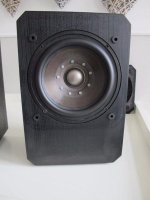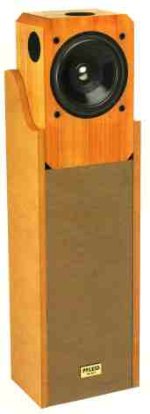In fact in my experience with 10” & 12” coaxes, and contrary to popular belief as expressed here, it’s beneficial to use the driver as low as possible.
Hi Airvoid,
I don't get that point. And it goes against my own experience: i observed a 'gain in quality' each time i relieved a coax ( and -small- full range) from bass duty. I've played with a bunch of them till now ( with pa from 15" to 10", studio 15" to 5" coax, 5"/4" full range) and it was always the same, xover in the 200/300hz ( 500/600hz for 5" coax or full range) range and it sounds way cleaner to me.
The most obvious is with smaller size ( 8" and smaller): with my 8" Tannoy at high spl there is some 'gargling' happening, you can definitely hear the highs being modulated by the lows, it sound like no other distortions to me ( really special).
With bigger diameter it is less obvious but still hp gives a cleaner ( subjective i know) sound. I suspect the same gargling could be observed too but at unbearable SPL level so less encountered ( even on stage in wedge use).
I don't think it's doppler distortion ( i'm sceptical it can be heard too), more a kind of intermodulation distortion.
Could you explain more in depth your view on leting the woofer part run in the lows please? What are the benefits to you ( technical/theorical and subjective)?
Coaxial should have advantages in the time domain. Therefore better impulse response.
Whenever I placed a tweeter directly before the bass mid driver in a two way it sounded more coherent. Like with fullrange drivers. Or close to it.
However I only use fullrange drivers and tweeters only sometimes for indirect reflections to the sides. Cut steeply at 5khz they do not disturb phase coherence in the mids.
Prominent example for the latter technique with indirect reflecting tweeters was the Pfleid FRS20 as small box or standing box.
Whenever I placed a tweeter directly before the bass mid driver in a two way it sounded more coherent. Like with fullrange drivers. Or close to it.
However I only use fullrange drivers and tweeters only sometimes for indirect reflections to the sides. Cut steeply at 5khz they do not disturb phase coherence in the mids.
Prominent example for the latter technique with indirect reflecting tweeters was the Pfleid FRS20 as small box or standing box.
Attachments
Genelec and Kali pursuing coax is all I need to know that it's something worth looking into and listening to.
Coaxial should have advantages in the time domain. Therefore better impulse response.
SHOULD is the important word in the sentence imho. 😉
It's not mandatory: i've had enough example where delay is needed to compensate for different emiting point in Z axis between both drivers. I've seen other strategiy in passive to achieve something close too ( on previous version of Great Plain Audio site there was a great example in the 'tech corner' about how to achieve something close to Urei's 'time coherent' monitors for their 604 recreation- it should be accessible through wayback machine through) but passive is not my thing... dsp user.
In fact i should say the only coax i played with which don't have this are Kef driver. I heard the late small diameter Tannoy ( white/silver membrane) had this too.
Some recent B&C too iirc.
The coincident location does indeed bring 'something' (at least to me) as full range and the MEH seems to have a certain appeal to people too.
But I've seen people disliking this to the point we needed to change monitors for them to work correctly. It's a preference thing and as we don't all listen to same things some point in rendering can have greater importance.
Genelec and Kali pursuing coax is all I need to know that it's something worth looking into and listening to.
You should try yourself.
Here's me 3 way- with separate LF (x2) + MF + HF
Here's me 3 way with LF + coax MF+ HF
A lollipop if you can tell me what is "better"
Last edited:
Must be easy when one can get kef drivers. I think the only good looking one to me is the sica 5".
I'm working with the W4-2315 recently, paired with 1139, hopefully doing sweeps today...

I present Monoculus... xovers pending...


This comparison is a little bit unfair, since the non-coax 3 way utilizes a tweeter without waveguide on a relative large (compared to the tweeter), flat, sharp edged baffle and a large midrange driver (so a directivity mismatch and unwanted diffraction effects are guaranteed) and the coax 3 way uses one of the best coax mid-high on an optimized baffle.You should try yourself.
Here's me 3 way- with separate LF (x2) + MF + HF
View attachment 1192639
Here's me 3 way with LF + coax MF+ HF
View attachment 1192640
View attachment 1192642
A lollipop if you can tell me what is "better"
Of course a coax is still more of a point source than any separate-driver multiway speaker, but this latter can be much better than the example seen above.
Last edited:
It's totally unfair fight, I agree. When I fired it up I was just a little underwhelmed. I think it was the 10dB in lower sensitivity/max SPL handling due to a single 8" woofer vs twin 12" woofers.
The dynamic range difference was just too hard to ignore. So I it turned it upside down, disconnect the 8" LF, and retuned the crossover for the twin 12" woofers. Here they are again with 25dB vertical scale.



As some shall ask- here's reverse phase-


Exhibit B:





The dynamic range difference was just too hard to ignore. So I it turned it upside down, disconnect the 8" LF, and retuned the crossover for the twin 12" woofers. Here they are again with 25dB vertical scale.
As some shall ask- here's reverse phase-
Exhibit B:
Last edited:
Can you say which are the respective drivers on both designs?You should try yourself.
Here's me 3 way- with separate LF (x2) + MF + HF
View attachment 1192639
Here's me 3 way with LF + coax MF+ HF
View attachment 1192640
View attachment 1192642
A lollipop if you can tell me what is "better"
Woofer bin:
Tymphany Peerless P830845 x 2
KEF SP1753 (coax taken from KEF R3)
Exhibit B:
B&W 6” FST (custom model based on LF00463)
Tymphany Peerless XT25BG60
Tymphany Peerless P830845 x 2
KEF SP1753 (coax taken from KEF R3)
Exhibit B:
B&W 6” FST (custom model based on LF00463)
Tymphany Peerless XT25BG60
When the sensitivity differences are adjusted for, the basic system sensitivity in passive form is about 92dB/2.83V because of the twin woofers. And although they only go down to 50Hz, the dynamic range is just breathtaking- 20W takes them over 102dB; which is where other speakers already start to become very strained (dynamic range compression and/or or harmonic distortion).
Percussions just hit so cleanly. The body and viscera really feel it; not just the ears. It makes you want to get up and jump and dance along. Program material with moments of relative quietness followed by melancholy can bring me to want to have tears; a kind of cathartic experience.
the wide dispersion but followed by the narrowing highs vs controlled directivity - what do I prefer- I can’t really say!!! 🤷♂️
I think I need to do some longer term listening tests…
Percussions just hit so cleanly. The body and viscera really feel it; not just the ears. It makes you want to get up and jump and dance along. Program material with moments of relative quietness followed by melancholy can bring me to want to have tears; a kind of cathartic experience.
the wide dispersion but followed by the narrowing highs vs controlled directivity - what do I prefer- I can’t really say!!! 🤷♂️
I think I need to do some longer term listening tests…
Last edited:
@tktran303: Don't want to distract the thread. But you may want to look at the woofer box directivity once again and might want to use the force to gradient option in VituixCAD while merging nearfield & farfield responses. I used to have similar looking low frequency polars until @hifijim & @fluid taught me things that are described from about here on 🙂
https://www.diyaudio.com/community/threads/a-3-way-design-study.376620/post-7142256
https://www.diyaudio.com/community/threads/a-3-way-design-study.376620/post-7142256
Thanks for heads up Vineeth. I was wondering why they look like that when I have measured to be omni to about 150Hz… in some other thread.
Thanks. Very helpful.
Thanks. Very helpful.
I can highly recommend the new R3 meta. I have the original R3 and R3 meta Infront of me right now.When the sensitivity differences are adjusted for, the basic system sensitivity in passive form is about 92dB/2.83V because of the twin woofers. And although they only go down to 50Hz, the dynamic range is just breathtaking- 20W takes them over 102dB; which is where other speakers already start to become very strained (dynamic range compression and/or or harmonic distortion).
Percussions just hit so cleanly. The body and viscera really feel it; not just the ears. It makes you want to get up and jump and dance along. Program material with moments of relative quietness followed by melancholy can bring me to want to have tears; a kind of cathartic experience.
the wide dispersion but followed by the narrowing highs vs controlled directivity - what do I prefer- I can’t really say!!! 🤷♂️
I think I need to do some longer term listening tests
There is no visible difference, but they are different enough to listen to that I don't really like the sound of the non meta (even EQed to Erin's spinorama data) yet the Meta is a joy to listen to. Somehow it brings out the micro dynamics in voices that give the emotion.
I high pass them at 150hz to a 18 bass driver as little bookshelf speakers simply cannot slam.
I am now saving for the Reference 1 Meta.
In any case, except for the Peerless woofers and tweeters, it's impossible to buy the KEF coax and the B&W 6". Anything close to them to replace them available to buy anywhere?Woofer bin:
Tymphany Peerless P830845 x 2
KEF SP1753 (coax taken from KEF R3)
Exhibit B:
B&W 6” FST (custom model based on LF00463)
Tymphany Peerless XT25BG60
Why, yes there is- for a 5-6” midrange, closest available equivalent is a Purifi 5-6” midrange.
For a high performance coaxial here is @5th element prototype’s
http://www.5een.co.uk/SB17Coax.htm
We are working on it to get it manufactured.
FAQ:
No ETA yet. It’ll be done when it’s done.
For a high performance coaxial here is @5th element prototype’s
http://www.5een.co.uk/SB17Coax.htm
We are working on it to get it manufactured.
FAQ:
No ETA yet. It’ll be done when it’s done.
Last edited:
- Home
- Loudspeakers
- Multi-Way
- The Pros & Cons of Dual-concentric/Coaxial drivers

